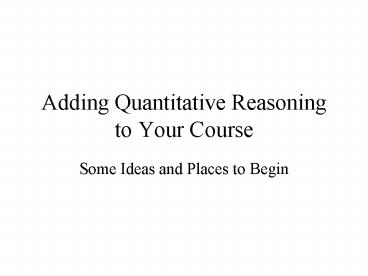Adding Quantitative Reasoning to Your Course - PowerPoint PPT Presentation
1 / 21
Title:
Adding Quantitative Reasoning to Your Course
Description:
... as about applying elementary tools in sophisticated settings' (Steen, 2001) ... Instruction on applying mathematical concepts and techniques to solve problems ... – PowerPoint PPT presentation
Number of Views:50
Avg rating:3.0/5.0
Title: Adding Quantitative Reasoning to Your Course
1
Adding Quantitative Reasoning to Your Course
- Some Ideas and Places to Begin
2
Topics for Today
- What is Quantitative Literacy?
- What is a Q Course?
- One Idea for Adding Q to a Course
- Some Useful Resources
- Considerations to Keep in Mind
3
What is Quantitative Literacy?
- Quantitative Literacy is not so much about
understanding abstract concepts as about applying
elementary tools in sophisticated settings
(Steen, 2001)
4
What is a Q Course?
5
Requirements for a Q Course
- Instruction on applying mathematical concepts and
techniques to solve problems - Assessment via at least 2 assignments
- Feedback
6
Types of Q Courses
- Courses where Primary Purpose is Q
- Courses where Q is Central to Content
- Courses where Q can Supplement or Enhance Student
Learning
7
Adding Q to a Course
8
Adding Q to a Course
- May take existing Q and make it more explicit and
intentional - Consider adding Q project(s)
9
Premises to Remember
- Choose Topics where Q will enhance student
understanding of the material - Math need not be complex
- It is fine to use the same Math over over, but
in different ways and different contexts - We are developing habits of the mind
10
Sources of Ideas
- Historically significant problems (for field)
- Current Events / Popular Press for the field
- CETL
11
Some Useful Resources
12
Some Useful Web Resources
- Dartmouth College Center for Mathematics and
Quantitative Education - Carleton College Teaching Quantitative Skills in
the Geological Sciences - Macalester College Quantitative Methods for
Public Policy - Woodrow Wilson National Fellowship Foundation
13
Considerations to Keep in Mind
14
Student Background
- Calculator Generation
- Tend to think of Math as formula to get the
right answers rather than about what the
information can tell them - Many of them have taken a lot of Math courses -
They may tune out that which seems familiar
15
Student Attitudes
- A student's interest in Math is more important
than their own perceived ability in determining
whether they take a Math course. - Real life applications make Math more
approachable and interesting. - Students like an interdisciplinary approach.
16
Learning Principles
- Learners use current knowledge
- Students need to be assisted in learning
meta-cognitive strategies - People learn more efficiently with feedback
17
Experts vs. Novices
- Experts and Novices store and apply knowledge
differently
18
Experts Knowledge Organization
- rich knowledge hierarchical organization
- notice and remember large amounts of complex info
after a short exposure - cue in on major idea needed to solve problem
- knowledge linked to conditions where it applies
19
Novices Knowledge Organization
- Info more like a sock drawer with t-shirts and
shorts thrown in a well. - Lots of energy spent trying to figure out what
relevant info they have, tend to focus on surface
similarities.
20
Developing Expertise
- Expertise is acquired over time depends on
multiple experiences - Need to teach organization as well as content
- Need to teach principles that underlie equations
and not just the equations
21
Transfer of Knowledge
- Transfer of Knowledge from one context to another
is neither trivial nor automatic - It is facilitated by knowing multiple contexts
where knowledge applies































